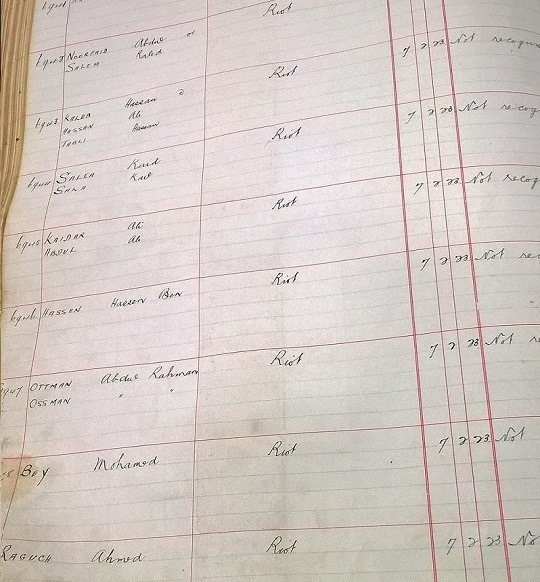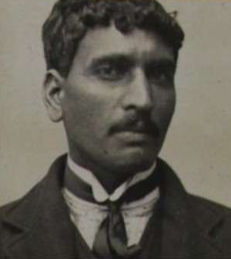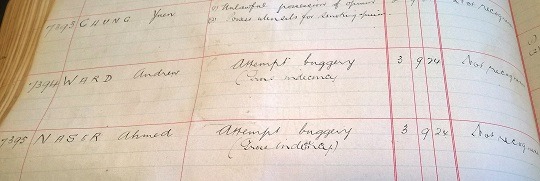Welsh LGBT+ and Black History?
February was LGBT+ History Month in the UK and Black History Month in the
US. Yes, both the shortest month. Black History Month in the UK is October, as
is LGBT History Month in the US. That these two coincide gives an opportunity
to uncover more histories of LGBT+ People of Colour.
There are certainly many Queer People of Colour to be celebrated -see reblogs on my tumblr blog with LGBT+ people celebrated in Black History Month. But when so many are American - the blogs, posts and articles by Americans - where is the UK history of Queer People of Colour, let alone a history of Queer People of Colour in Wales? Where was their history in UK’s LGBT+ History Month? What coinciding LGBT+ and Black History Months has highlighted is we need to uncover the history of Queer People of Colour in our whole history, and decolonising our history has to be ongoing, not just celebrating these figures once or twice a year.
In the historiography (the literature of Welsh LGBT+ History) there is practically nothing, no history of Queer People of Colour in or from Wales. Kirsti Bohata writes on postcolonial theory and Queer themes in literature - in her chapter in Queer Wales, the presence of queer women is explored in the literature of Wales, as well as on the borders of Wales (gendered borders and borders of Nationhood, which are apparent in Welsh literature, such as Margiad Evans’), where the are negative images of Blackness. In the history, Cliff Gordon is said to have ‘discovered’ Shirley Bassey, when he cast a musical on the life of Al Jolson. These are very tenuous links between Welsh LGBT+ History and Welsh Black history, the literature on which is itself also sparse.
To search for any history of Queer People of Colour in Wales, I first looked through the Fingerprint and Photographic Registers at Glamorgan Archives. Glamorgan Archives have already posted some examples of LGBT+ people arrested in these records - men arrested for ‘buggery’ and ‘gross indecency,’ including of Abdulla Taslameder, and Martha Alice Hodson, arrested for committing crimes while ‘masquerading as a man.’ Crime records have more information on working class people, rather than those who already make up LGBT+ History, and when there is little information on the people arrested, the photographs give more indication on where People of Colour were arrested, rather than just going by their name.
Immigrants’ names might be more apparent, but this of course would not be true for all. These records do note when individuals have been reported, such as with ‘Louis Perlin,’ arrested for ‘Gross indecency with male person’ on the 11th of January, 1910 and discharged by ‘Expelled.’ See previously linked blog post for images. Though his name is written as Louis Perlin here, in the format of the registers, it should be Perlin Louis. Perlin as a first name can be Jewish, or German. Confusion over names in the records (with names of immigrants) would not be surprising - Louis Perlin as a name could be again European (Eastern European, German, French) or American.
John Gevas was arrested on the 16th of April, 1912 for ‘Buggary attempted’ and was in the Assizes on the same date and on the 11th of July, 1912. He was sentenced to 12 months of hard labour and ‘recommended for expulsion’ - he was expelled to Greece on the 13th of May, 1913.


Immigrants, sailors, and others are arrested in the records, with large numbers of arrests of People of Colour in places. More than once there are examples of groups of Black men or groups of Asian men arrested together, and a handful of times there are all, or mostly, arrested for ‘Riot.’ i.e.


These are 8 men arrested for Riot on the 7th of February, 1923 (Abdul Norfaid or Kaled Salem; Hassan Kaleb/Kalea, Ali Hassan or Hassan Tabli; Kaid Saleh or Kail? Sala; Ali Kaidar or Ali Abdul; Hassen Ben Hassen; Abdul Rahman Ottman or Abdul Rahman Ossman; Mohamed Bey; Ahmed Raguch.)
(Glamorgan Archives, DCONC/3/2/6)
This history itself absolutely need to be looked at, as does the criminalisation of people for their sexuality. This is a part of Wales’ history, if not always the populations in Wales, then how Wales was (or is) complicit in the criminalisation of individuals for their sexuality and/or for their race.
Here are Queer People of Colour arrested in Wales who are in the Fingerprint and Photographic Registers at Glamorgan Archives:


Abdulla Taslameder, also written as Abdulla Talameden, was arrested, or finger printed, on the 15th of August, 1918, for ‘Buggery,’ with no previous record found? He was sentenced, on the 6th of November, 1918, at Glamorgan Assizes, to 12 months of hard labour. An obvious issue arises looking at these records of his name being written differently in, which is an issue with the reading of the handwriting, which mostly looks like Taslameder, but there can also be the issue of the people writing their names. I have not yet found more about Abdulla Taslameder.

(Images via Glamorgan Archives blog, Queering Glamorgan, & Glamorgan Archives, DCONC/3/2/4)
On the 3rd of September, 1924, Andrew Ward and Ahmed Naser were arrested for Attempting ‘Buggery (Gross Indecency)’ and both were sentenced to 6 weeks of Hard Labour on the 11th of November at Glamorgan Assizes. Certainly they were arrested together and receiving the same sentence suggests it was a consensual act they ‘attempted’ and were punished for.


(Glamorgan Archives, DCONC/3/2/6)
What I’ve most recently found: Abdul Nagi was arrested also for ‘Buggery’ on the 20th of March 1930 and at Glamorgan Assizes on the 22nd of June was discharged. (Also in this record is that of Mohamed Shirrih, arrested for landing in the UK without permission of Immigration Officer – Deportation is recommended, presumably after first serving his sentence of 21 days of Hard Labour at Police Court.

(Glamorgan Archives DCONC/3/2/7 )
This is the history of Queer People of Colour in Wales that I have found so far - there is also an issue of more recent archives cannot be accessed (and should not be explicitly shared to possibly out anybody, of course). This is just a start to uncovering this history, as there is so much more LGBT+ history as a whole to uncover, and the histories of People of Colour need to be told in Wales so much more than they currently are. This blog post however has hopefully shown that the records of this history do exist to be researched in future - in a future decolonised history of Wales.
If you know anything more about the history of Queer People of Colour in Wales, feel free to correct me or contact me!
Quick notes:
There are certainly many Queer People of Colour to be celebrated -see reblogs on my tumblr blog with LGBT+ people celebrated in Black History Month. But when so many are American - the blogs, posts and articles by Americans - where is the UK history of Queer People of Colour, let alone a history of Queer People of Colour in Wales? Where was their history in UK’s LGBT+ History Month? What coinciding LGBT+ and Black History Months has highlighted is we need to uncover the history of Queer People of Colour in our whole history, and decolonising our history has to be ongoing, not just celebrating these figures once or twice a year.
In the historiography (the literature of Welsh LGBT+ History) there is practically nothing, no history of Queer People of Colour in or from Wales. Kirsti Bohata writes on postcolonial theory and Queer themes in literature - in her chapter in Queer Wales, the presence of queer women is explored in the literature of Wales, as well as on the borders of Wales (gendered borders and borders of Nationhood, which are apparent in Welsh literature, such as Margiad Evans’), where the are negative images of Blackness. In the history, Cliff Gordon is said to have ‘discovered’ Shirley Bassey, when he cast a musical on the life of Al Jolson. These are very tenuous links between Welsh LGBT+ History and Welsh Black history, the literature on which is itself also sparse.
To search for any history of Queer People of Colour in Wales, I first looked through the Fingerprint and Photographic Registers at Glamorgan Archives. Glamorgan Archives have already posted some examples of LGBT+ people arrested in these records - men arrested for ‘buggery’ and ‘gross indecency,’ including of Abdulla Taslameder, and Martha Alice Hodson, arrested for committing crimes while ‘masquerading as a man.’ Crime records have more information on working class people, rather than those who already make up LGBT+ History, and when there is little information on the people arrested, the photographs give more indication on where People of Colour were arrested, rather than just going by their name.
Immigrants’ names might be more apparent, but this of course would not be true for all. These records do note when individuals have been reported, such as with ‘Louis Perlin,’ arrested for ‘Gross indecency with male person’ on the 11th of January, 1910 and discharged by ‘Expelled.’ See previously linked blog post for images. Though his name is written as Louis Perlin here, in the format of the registers, it should be Perlin Louis. Perlin as a first name can be Jewish, or German. Confusion over names in the records (with names of immigrants) would not be surprising - Louis Perlin as a name could be again European (Eastern European, German, French) or American.
John Gevas was arrested on the 16th of April, 1912 for ‘Buggary attempted’ and was in the Assizes on the same date and on the 11th of July, 1912. He was sentenced to 12 months of hard labour and ‘recommended for expulsion’ - he was expelled to Greece on the 13th of May, 1913.


Immigrants, sailors, and others are arrested in the records, with large numbers of arrests of People of Colour in places. More than once there are examples of groups of Black men or groups of Asian men arrested together, and a handful of times there are all, or mostly, arrested for ‘Riot.’ i.e.


These are 8 men arrested for Riot on the 7th of February, 1923 (Abdul Norfaid or Kaled Salem; Hassan Kaleb/Kalea, Ali Hassan or Hassan Tabli; Kaid Saleh or Kail? Sala; Ali Kaidar or Ali Abdul; Hassen Ben Hassen; Abdul Rahman Ottman or Abdul Rahman Ossman; Mohamed Bey; Ahmed Raguch.)
(Glamorgan Archives, DCONC/3/2/6)
This history itself absolutely need to be looked at, as does the criminalisation of people for their sexuality. This is a part of Wales’ history, if not always the populations in Wales, then how Wales was (or is) complicit in the criminalisation of individuals for their sexuality and/or for their race.
Here are Queer People of Colour arrested in Wales who are in the Fingerprint and Photographic Registers at Glamorgan Archives:


Abdulla Taslameder, also written as Abdulla Talameden, was arrested, or finger printed, on the 15th of August, 1918, for ‘Buggery,’ with no previous record found? He was sentenced, on the 6th of November, 1918, at Glamorgan Assizes, to 12 months of hard labour. An obvious issue arises looking at these records of his name being written differently in, which is an issue with the reading of the handwriting, which mostly looks like Taslameder, but there can also be the issue of the people writing their names. I have not yet found more about Abdulla Taslameder.

(Images via Glamorgan Archives blog, Queering Glamorgan, & Glamorgan Archives, DCONC/3/2/4)
On the 3rd of September, 1924, Andrew Ward and Ahmed Naser were arrested for Attempting ‘Buggery (Gross Indecency)’ and both were sentenced to 6 weeks of Hard Labour on the 11th of November at Glamorgan Assizes. Certainly they were arrested together and receiving the same sentence suggests it was a consensual act they ‘attempted’ and were punished for.


(Glamorgan Archives, DCONC/3/2/6)
What I’ve most recently found: Abdul Nagi was arrested also for ‘Buggery’ on the 20th of March 1930 and at Glamorgan Assizes on the 22nd of June was discharged. (Also in this record is that of Mohamed Shirrih, arrested for landing in the UK without permission of Immigration Officer – Deportation is recommended, presumably after first serving his sentence of 21 days of Hard Labour at Police Court.

(Glamorgan Archives DCONC/3/2/7 )
This is the history of Queer People of Colour in Wales that I have found so far - there is also an issue of more recent archives cannot be accessed (and should not be explicitly shared to possibly out anybody, of course). This is just a start to uncovering this history, as there is so much more LGBT+ history as a whole to uncover, and the histories of People of Colour need to be told in Wales so much more than they currently are. This blog post however has hopefully shown that the records of this history do exist to be researched in future - in a future decolonised history of Wales.
If you know anything more about the history of Queer People of Colour in Wales, feel free to correct me or contact me!
Quick notes:
- I have used the term ‘Queer People of Colour’ as this is useful in history for people whose specific sexuality we do not know, as well as where they were from in this case.
- There are many more records I need to look at to search for more.
- Images have been cropped and slightly enhanced to fit this blog and be more readable - you can contact me for the originals and to ask about the rest of my research! (Or suggest what more I could post about!)
- You can support me at Ko-Fi, if you so wish!
- Glamorgan Archives, Fingerprint and Photographic Registers, DCONC/3/2/1-7 - used: DCONC/3/2/3-7, 1910-1933)
- Glamorgan Archives LGBT blog post.
- Norena Shopland, Daryl Leeworthy, ‘Queering Glamorgan,’ Glamorgan Archives.
- Yasmin Begum, ‘An independent Wales must undo the darkness of white supremacy’, Planet, 2018. (Yasmin Begum, and others, have written on the decolonisation of Wales.)
- Kirsti Bohata in Huw Osborne ed. Queer Wales: The History, Culture and Politics of Queer Life in Wales, 2016 / other writing by Kirsti Bohata.
- William Cross, The Abergavenny Witch Hunt: An Account of the Prosecution of Over Twenty Homosexuals in a Small Welsh Town in 1942, 2014. (Includes information on arrest of Cliff Gordon, as well as on LGBT arrests in the period.)
- Norena Shopland, Forbidden Lives: Lesbian, Gay, Bisexual and Transgender Stories from Wales, 2017. (More on Cliff Gordon and many, many others.)

Comments
Post a Comment